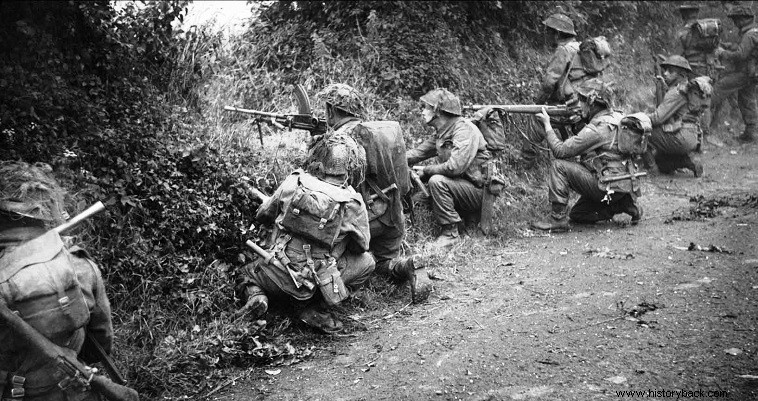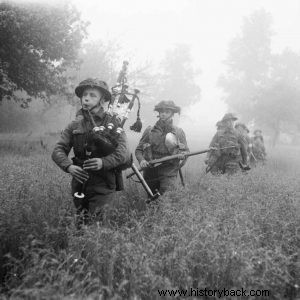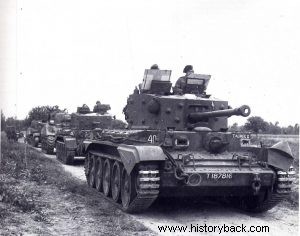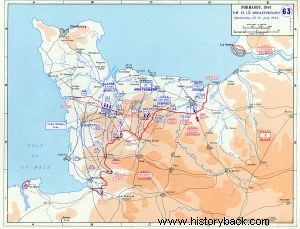
Immediately after the formation of the front in Normandy, after the successful landing of the Allied forces there, the objective of the Allied leadership was to anchor the German armored forces in the sector of the British 2nd Army (2nd Army) so as to give the ability for the US 1st Army (1st Army) to achieve a breach of the German defensive location. This was also the aim of Operation Bluecoat.
The Allied command tried to convince the Germans that the main blow against them would come from the British and not the Americans. In this context, operations "Epsom", "Goodwood" and "Cobra" were carried out. So it was decided to carry out a new British, deceptive and not only attack, codenamed "Bluecoat". The attack would be undertaken by the VIII and XXX Army Corps (SS) of the British 2nd Army (2nd BC). The VIII SS under Lieutenant-General O'Connor, would attack the axis Chamont-Viret-Hill 309.
The vanguard of the VIII SS was the Scottish 15th Infantry Division (MP) . The Scots had old open accounts with the Germans from previous battles and a deep hatred had developed between the two rivals as, as was their usual practice, the Germans had brutalized and murdered Scots prisoners. So in the ranks of the 15th MP there was a silent oath about not taking prisoners.
The 15th MP would be directly supported by the 6th Guards Armored Brigade (6th TTH/TXF) with 4 divisions. The 6th Infantry Division fielded a total of 174 tanks, mainly Churchill Mark VII and Mark VIII, some armed with a 75mm cannon, the other with a 95mm howitzer. In addition, Churchill (Crocodile) flamethrower tanks and Sherman tanks with mine-clearing cylinders of the famous British 79th Armored Division (ATD) were made available to the VIII SS.
Against the first British echelon of the VIII SS was deployed the German 326th MP, which had suffered from the previous battles and was supported by the 654th Tank Fighter Regiment, equipped with 20 (other sources speak of 30) Jagdpanthers tank hunters.>
Infantry, tanks and air force sortie
At 06.55 on 30 July the British set out. The British, without much difficulty, captured Le Bourgh. Sept Wench proved a tougher nut to crack. The Germans defended themselves brilliantly, from house to house and bush to bush, but when British tanks arrived they withdrew. In this way, the first phase of the attack ended, with the British having captured all the objectives that had been set, without particularly serious difficulties and losses.
However, although the German front had broken up, German divisions remained cut off behind the new British lines, causing casualties and concern. The cut off Germans showed no intention of giving up the fight and as the British forces tried to gather on the advance line to start the second phase, they came under heavy fire.
Nevertheless, against the motorized British paver, the Germans either retreated or were neutralized. The British soon after began the second phase of the attack. Gradually the British forces, tanks and infantry, gained more ground, but much more slowly now, as the German resistance strengthened. However, the commanders of the 6th TTH/TXF and the 15th MP decided, on their own initiative, to change the plans, proceeding with an unorthodox, but also daring maneuver, sending the tanks ahead by themselves and leaving the infantry to clear the ground.
The advance continued and at 14.00 the tanks were joined by the Scottish infantry of the Highland Light Infantry, who had meanwhile cleared the area of German infantry. Between 15.00, one swarm after another of British bombers appeared over the British lines targeting Hill 309. Soon the hill was covered in thick smoke. All that could be seen were the flashes from the explosions, felled trees and men flying through the air.
According to the plan the attack against Hill 309 would be covered by the XXX SS. But this corps did not succeed, right from the start, in keeping with the plan, due to poor organization of the attack, but also due to the extensive German minefields. Nevertheless and despite the losses by 16.30 the British were on Hill 309, facing sporadic German fire. By 18.00, hill 309 was, absolutely, under their control.
Until that moment the Germans, taken by surprise by the unexpected and powerful blow they had received, had not reacted seriously to the British attack, leaving the 326th MP to face alone the burden of the attack of the entire VIII SS.
Suddenly, however, tanks of Major Whitelaw's Company S, which formed the left of the British defensive arrangement on the hill, exploded. Two entire ulams of chariots were set on fire, seemingly without explanation. But the British soon understood, when they saw three Jagdpanthers appear through the vegetation , believing that they have destroyed all the British tanks in the area. Immediately the British opened fire, but only managed to force the German tank hunters to retreat, but not before they destroyed a few more British tanks. Eventually two of the three Jagdpanthers were abandoned, having been hit in the tracks.
As night fell the battle stopped. The VIII SS had managed to advance to a depth of 9 km into the German formation, winning all of the day's objectives, with relatively light losses. Specifically, the 15th Scottish MP had only 223 men out of action, while the 6th Infantry Division had 72 men and 35 tanks out of action. Of these, 11 were immediately repaired and participated in the continuation of the battle. The three German Jagdpanthers had proved their worth by destroying 12 British tanks.



